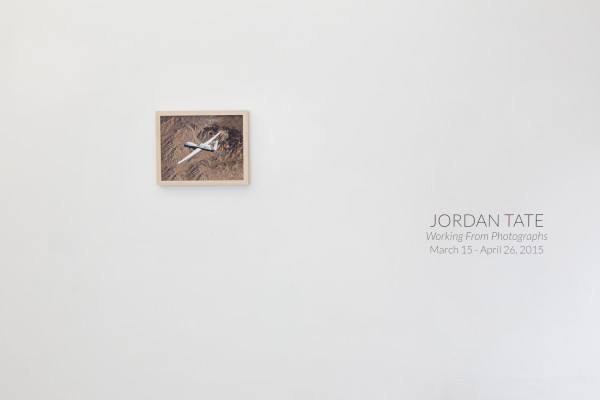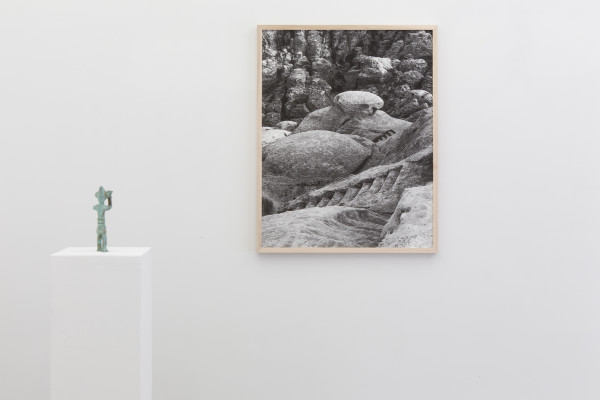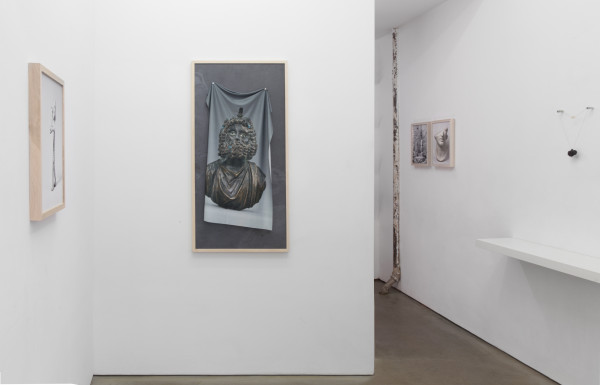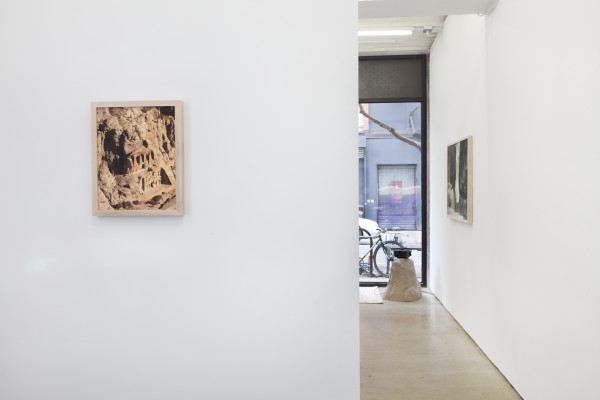Jordan Tate
Friday, 17 April 2015
Work from Working From Photographs.
This interview accompanies Jordan Tate’s exhibitions, Working From Photographs, at Denny Gallery in New York City from March 15 to April 26, 2015, and concurrently at Angela Meleca Gallery in Columbus, Ohio. The title of the exhibition, “Working From Photographs,” refers both to
Tate’s background as an artist who has primarily worked in the medium
of photography and to the photographic origins of much of our experience and knowledge of the subjects of the exhibition. Tate’s works include photographs of objects and objects based on photographs, ancient artifacts as well as modern day tourist photography, and thus he makes deliberately ambiguous the relationship between the artwork constructed by the artist in a studio and the appropriated image mined from vast, heterogeneous sources.
Jordan Tate (JT) interviewed by Elizabeth Denny (ED), March 2015.
ED: Why did you choose to call your second solo exhibition with Denny Gallery “Working From Photographs”?
JT: I view the photographic as the primordial medium of the post-internet era. Given my process, and the modus operandi of visual inquiry and production, I wanted to pay homage to the photograph both as the root of my experience, as well as the expansive governing force in work.
ED: What kind of artist are you?
JT: That is a more difficult question to answer than I would expect. Conceptually and rhetorically, I still very much consider myself a photographer, but materially I view myself as simply as an artist. This is in some way an attempt to have a discursive home in a medium to provide context for my work, thought process, and practice, while at the same time affording me the freedom to wildly experiment with forms and processes that aren’t traditionally considered photographic.
ED: What is the difference between the two sites of Working from Photographs- South America/Rapa Nui (exhibited at Angela Meleca Gallery) and The Levant (exhibited at Denny Gallery)?
JT: There is an important geographical and chronological shift that occurs between the two shows that acknowledges the photographic compression of these entities (8,000 miles and 3,000 years), and while both focus on “ancient” or “primitive” cultures, they, at their core deal with the notion of removed perception. The idea of removed perception to me is essentially photographic, in that the photograph can replace in us the need (or desire) of “having been there,” which may have been crucial to understand the thing.
While the archival photographs from the Met Museum do their best to capture the likeness, presence, or aura of the art objects they depict, they are still not “there”; there is a slippage between what we perceive as reality and what we perceive as the image. This has been my core concern with the photograph for the past decade.
The exhibition at Angela Meleca gallery focuses on 14th century South America and Rappa Nui while the exhibition at Denny Gallery in New York addresses the Levant (contemporary Middle east) circa 2000 B.C.E. to 0. While these two times and places are worlds apart, our perceptions are far less removed than that. The difference here is political – we view the Levant as a highly volatile region that governs (either through religion, history, or energy policy) a great deal of world politics – yet culturally, we group the Mesopotamians, Assyrians, Aztecs, Mayans, and all other so-called primitive peoples in the same group – ignoring the fact that Machu Picchu was constructed in the time of Michelangelo and 500 years after the founding of Oxford University.
And therein lies the rub – we celebrate Isaac Newton as one of the greatest minds in history while ignoring the unquantifiable contributions of cultures not embraced by western history– when the Levant could be considered to be the birthplace of writing, mathematics, literature, the wheel, astronomy, banking, and a code of laws.
ED: Unusually for an artist working with photography, your works have a strong immediacy that cannot be anticipated by looking at the images of the work. In this show, I was most struck by the appearance of printing dots that reveal that some of the images are scanned from books. Why is it important to consider the objecthood of the work and what factors into that consideration for you?
JT: Fundamentally, I was interested in showing the trace (origin) of the images. In a way, this happens in an archeological sense where you can see the “artifacts” of the printing process when translated to a different context. I wanted to acknowledge sources for the images that have the half-tone patterns and in that dialogue begin a discourse with myriad forms of the photograph both in a contemporary and historical context.
ED: You have used images of antiquities and ancient art in your work in the past. What dialogue do you wish to have with these objects? Or is the dialogue with the images, archiving techniques and historical preservation of these ancient things?
JT: Ironically, the sculptural artifacts are where the work gets more photographic. I am interested in the early polemics of the photograph as a medium that is capable of compressing both distance and time through the pursuit of taming the exotic and allowing the viewer, in a sense, to own an experience through the image. In many ways I am trying to point out the disconnect between the photographs, these places, and the objects and histories that have been codified into our understandings of “primitive” cultures.
ED: You openly appropriate or source images from various places, including images of artworks in books and museums’ image archives of their collections. Where do you stand on these issues or what do you find to be interesting about them?
JT: Fundamentally, I see photography existing in two ways, one as the constructed image (i.e. studio shot) and the other as inherently appropriative (assemblage of the visible world). I think this is what keeps me connected to the mind of a photographer – the act of appropriating an image from a museum archive (which is a pallid reproduction of a cultural artifact) or a book to me isn’t inherently different than traveling to Petra to photograph it for myself, as the images of Petra are largely preformed in my mind from the deluge of images in the cultural milieu starting with National Geographic and ending with Indiana Jones.
ED: Where do your source images come from? Are you “faithful” to the quality of the images you appropriate or do you manipulate them to improve their quality or resolution?
JT: The artifacts came from the collections of the Metropolitan Museum of Art and the Antikenmuseum Basel und Sammlung Ludwig. The idea of faithfulness is an interesting and tricky notion, are the images edited? Often. Are they faithful? I would argue, yes. I guess I would argue that I am faithful to the spirit of the law rather than the letter of the law (as the saying goes).
ED: Is the viewer you have in mind for this body of work culturally specific?
JT: No, just culturally aware.
ED: One of the pieces is a virtual reality video that will visually transport the viewer to the environment of the Middle East, where the United States has been at war for much of the past twenty-five years. Will the viewer feel like they are in a military training exercise?
JT: I think if it did look like a military training exercise it would be a very boring and ineffective one given the vastness and openness of the desert I am depicting. The war thing is tricky, and I am using the desert to set the tone and context of the region as a place and lived in landscape. It will be a sort of forced first person perspective.
ED: Militant extremists in the Levant, namely ISIL, have been looting or destroying archaeological treasures of the region in order to fund and fuel their activities. Is it a coincidence that while you were working with the material history of the region, mediated through photographs of its archaeological sites and artifacts, the destruction of such objects would be performed for video broadcast for international viewing?
JT: While the Levant is a historically fraught region, the work wasn’t prescient in the sense that I was directly engaging in the iconoclasm of ISIL. That said, I did want to address the irreplaceable contributions that have historically sprung from the Levant. Also, the notion of iconoclasm (particularly in this region) is one that was imported from Byzantine Christianity. I would also argue that the politics of representation and historical engagement with iconoclasm as a political action inform and historically contextualize the actions of ISIL in Mosul. However, a significant number of the artifacts in museums worldwide (and fortunately in Mosul) are plaster replicas, and the notion of historical “authenticity” and replication is one that I was quite purposefully dealing with.






